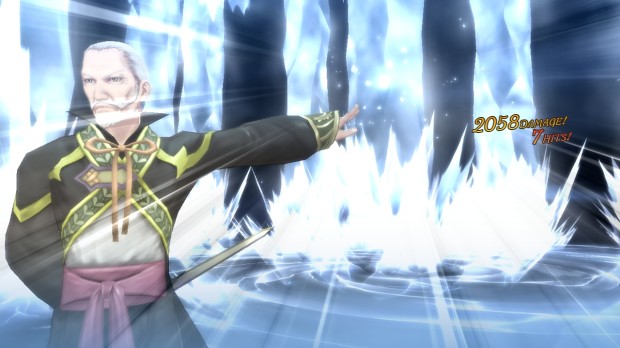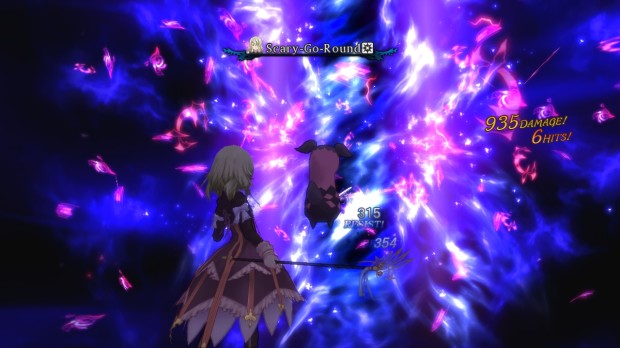Tales of Xillia Review
This game was reviewed on the PlayStation 3.
Tales of Xillia tells the story of two heroes, Jude and Milla, and their quest to help the spirits of their world. Within the game, spirits are essentially divine beings, who can convert a person’s natural mana into the equivalent of magic, Artes, through what’s known as Channelling. These abilities have become an everyday part of life, so when spirits stop responding to people’s calls, and Artes start to go awry, people begin to notice.
Enter our two protagonists. Jude is a promising honours student, who is studying to become a doctor, and was one of the first people to notice the decline in successful Artes. Milla’s origins, however, are shrouded in mystery. One thing is certain though: she has powerful control of the four great spirits (Efreet, Gnome, Sylph, and Undine). During two different and seemingly unrelated events (which I won’t spoil for you), the two discover a terrible and horrifying weapon. This leads to them ending up on the wrong side of the law and getting caught up in a conspiracy that reaches deep into a country’s government. However, like in any experienced JRPG, players will question if the original antagonist is really the brains behind it all, as things are not always as they seem. Just from the base story alone, there is enough quality and content to keep gamers coming back for more – “just one more hour” is a phrase you’ll find yourself saying quite often.
 Tales of Xillia’s narrative isn’t the only thing that makes it so addicting though; the attention to detail will also suck you right into the storyline. If you’ve played any game from the Tales of series from Namco, you’ll notice familiar elements such as the return of the great four spirits, as well as certain weapons and attacks. While these are used or named at least in minor ways across the series, each title (especially Xillia) finds a new and unique way to keep itself feeling fresh. In the previous title, Tales of Vesperia, these four spirits were used as key elements within the story; while the same can be said of Xillia, not once did I think to myself “you know, this feels a lot like Vesperia…” Though they may be similar in name, they are not in appearance or function. The same can be said for the lead characters; Jude is played by Sam Regal, who voiced the character Flynn in Vesperia. Although they may sound the same, they are two totally different people. This is partly due to script and character design (as Jude is less serious and more easygoing than Flynn), and partly due to the actual performance of the voice actor. While certain elements may feel familiar, they won’t feel rehashed, which is something the series has continued to do flawlessly for 15 years.
Tales of Xillia’s narrative isn’t the only thing that makes it so addicting though; the attention to detail will also suck you right into the storyline. If you’ve played any game from the Tales of series from Namco, you’ll notice familiar elements such as the return of the great four spirits, as well as certain weapons and attacks. While these are used or named at least in minor ways across the series, each title (especially Xillia) finds a new and unique way to keep itself feeling fresh. In the previous title, Tales of Vesperia, these four spirits were used as key elements within the story; while the same can be said of Xillia, not once did I think to myself “you know, this feels a lot like Vesperia…” Though they may be similar in name, they are not in appearance or function. The same can be said for the lead characters; Jude is played by Sam Regal, who voiced the character Flynn in Vesperia. Although they may sound the same, they are two totally different people. This is partly due to script and character design (as Jude is less serious and more easygoing than Flynn), and partly due to the actual performance of the voice actor. While certain elements may feel familiar, they won’t feel rehashed, which is something the series has continued to do flawlessly for 15 years.
Speaking of characters, Xillia gives you the option of who you would like to be the main character. While you may control any party member in and out of battle, at the start of the new game you’re given a choice for the storyline: Milla or Jude. Who you pick determines several things about how the game will play out, immediately noticeable in the beginning.
 Jude and Milla each have an origin story that shows how the two came together on their mutual quest. Due to Milla’s unknown origins and backgrounds (which are revealed later in the story), Jude’s is a bit more hearty on story and lore – making it a good first playthrough. Milla’s story jumps players into combat much more quickly than Jude’s, and spends less time setting up the scenes, which is great for players looking to start a second run. Other things affected by this choice include cinematics, and even the general mood. Within story scenes, should Jude and Milla split up, even if it’s just one walking out of a room, you typically follow the character you selected. So, if part of the story is, say, Jude goes to find a character, and Milla searches for information, you will go with the character you selected. This means that on two different playthroughs, you will get slightly different stories, and finishing both will leave you with a more complete sense of closure.
Jude and Milla each have an origin story that shows how the two came together on their mutual quest. Due to Milla’s unknown origins and backgrounds (which are revealed later in the story), Jude’s is a bit more hearty on story and lore – making it a good first playthrough. Milla’s story jumps players into combat much more quickly than Jude’s, and spends less time setting up the scenes, which is great for players looking to start a second run. Other things affected by this choice include cinematics, and even the general mood. Within story scenes, should Jude and Milla split up, even if it’s just one walking out of a room, you typically follow the character you selected. So, if part of the story is, say, Jude goes to find a character, and Milla searches for information, you will go with the character you selected. This means that on two different playthroughs, you will get slightly different stories, and finishing both will leave you with a more complete sense of closure.
What’s most affected by your character choice, though, is your sense of perspective. My first selection for play was Jude, and during my playthrough, even though I tried out all the other characters (of which there are six: Jude, Milla, Alvin, Elize, Rowen, and Leia)I still felt as though I was Jude – like the story was happening from his perspective. When I started a new game to try Milla’s side though, that viewpoint changed drastically. Even in scenes involving both characters, and factoring my playtime-bias towards Jude, I still felt as though Milla was the focal point the second time around. Again, this is thanks mainly to script writing and directing, as each game, though mostly similar, is handled in a way that makes them feel quite different. This choice is deserving of a huge kudos to the title’s team.
While the story and characters are definitely a major selling point for the title, the actual gameplay itself is quite entertaining and addictive, complementing the storytelling wonderfully. While outside of combat, players explore different towns, wild regions, and dungeon areas to progress the story. Aside from your usual mini-map, a quick touch of R1 will bring up your basic objectives. Should you need a better understanding of the area, or a reminder of what you’re doing, you may open either a full-screen version of your map, or a story primer which has the full details on your current quest. Several sub-quests are also available for you to take on, and often yield rewards in the form of gold, apparel, or augments.
Something gamers will notice quite quickly is the lack of an open world map. Instead of heading out onto a massive world to explore and roam freely, each town is connected directly by a Seahaven, Field, or Dungeon. Fields are simply lavish pathways filled with monsters, which are fairly easy to navigate with very few branching passages; Seahavens are ports where you select a town, and travel there by boat, and are ever only used within cutscenes; and Dungeons are pretty self-explanatory: these are complex areas to find your way through, usually possessing a boss at the end. As well, in the general story after visiting a town important to Milla very early in the game, you unlock a map that allows you to instantly travel to any location you’ve previously visited. This lack of an open world makes Xillia’s setting feel more like a massive building rather than a continent, and leaves the title feeling like it’s missing something – especially the instant travel. While many other RPGs let you freely explore and travel the world, the lack of an open setting and instant travel tend to break immersion, treating exploration as more of a chore than an option. While load-times are nearly non-existent, many gamers will question whether this setup is a step forwards or backwards for the series.
A huge part of Xillia is combat, which is comprised of both similar and new ideas for the series. Should you come into contact with an enemy on the world map, or be brought into a fight via story progression, you’re taken from exploration and into a 360-degree combat area via a load screen. In-game combat uses the same base mechanics as Vesperia, where players freely attack enemies in real time. Gamers openly traverse the battlefield, attacking the enemy with basic attack combos, the length of which is determined by your Attack Count (AC). The more you have of this, the longer you can attack. Players may also block and dodge attacks, as well as use offensive Artes.
While the barebones fighting setup feels directly pulled from the previous title, overall combat is drastically varied. Most notable is the Link system, which allows two characters to sync their attacks together into one gigantic move. By pressing the D-pad in the direction of a respective ally (as determined by your party layout at the bottom of the screen), you can Link with that character, which results in one of three separate strategies. Most commonly, they will proceed to move behind the enemy you’re currently locked onto, and promptly assault them from there, effectively creating a pincer move against the foe. This can lead not only to extra critical attacks, but lavish co-operative combos, often knocking enemies down or into the air. Secondly, your Linked ally may notice a foe’s attention shift toward you, and branch off to cover your back – which will be noted by the ally via a banner at the top of the screen. Finally, each character possesses a special Link ability or tactic that can be used to greatly change the direction of the battle. For example, when you link with Milla, she will attempt to catch your targeted enemy in a Bind, stopping them for moving for a short time. Jude, on the other hand, will use healing Artes to recover your HP should you be knocked to the ground. The frequency of these powers can be determined both by circumstance and enemy type, such as Alvin using a Guardbreak more often against armoured foes, or Elize using her Drain ability on enemies knocked into the air. Up to four characters can take part in battle at once, and two sets of two can be Linked at one time.
In typical Tales of tradition, players may use two different types of Artes within combat: martial and spiritual. As you can guess, martial Artes are physical attacks and/or buffs that focus mainly on close quarters combat, and spiritual Artes rely on magic power and prefer to keep a distance between combatants. Using an Arte, regardless of type, expends TP (Technique Points), and the cost of which varies greatly from one ability to the other. As well, certain skills draw more power from different stats, not just from physical or magical attack; some abilities may become more powerful if you have a high agility, and this is marked by that stat’s icon on the ability description. Furthermore, specific characters and Artes can be transformed or augmented through various commands in combat. For example, with Alvin, you can charge his skills to change his stance in order to use more powerful version of them. Many magic attacks can also be enhanced by pressing a specific button at the correct time. Knowing when to use and change these powers (and more importantly, when not to) is vital to your success in combat.
If you’re looking to deal some serious, fight-ending damage, then this next feature is for you: Arte Linking. As you Link with a character and attack foes, a meter on the left side of the screen will fill up, reaching five different increments with an icon at the top. Once a segment fills, the icon starts to flash and it is possible for you to unleash a Linked Arte, which combines two similar Artes into one powerful ability. For example, by combining Jude’s Cerberus Strike (an earth-based trio of punches) and Rowen’s Rock Trine (a triangle of rocky pillars protruding violently from the ground), you create Igneous Crush, an Arte that attacks with three massive floating fists made of earth, smashing the enemy with extreme prejudice. Should you acquire two or more segments in one go, you can chain multiple Linked Artes together for a massive combo of power and death!
What’s interesting about the Arte Link system is that once you’ve used the Linked Arte, the segment of the Link Gauge isn’t consumed – it stays filled. The icon stops flashing, however, and you’re unable to combine your powers. So, how do you reset the Link Gauge to start again? Simple; fill it and go into Overdrive! Once completely full, Linking two Artes will bring you into Overdrive mode, where you gain augmented stats and can chain Artes together as much as you want, until you run out of combinations – where you can start again if you still have time! This only lasts a few brief yet crucial seconds, so combine as much as you can, as fast as you can!
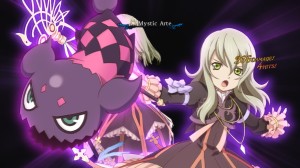 A lot can be said for Xillia’s defensive mechanics as well. As mentioned before, you can block and dash, but how you use these can really change a battle’s direction. While dashing backwards (if timed correctly during an enemy attack), you will instead teleport behind your foe, granting you additional AC and allowing you to take advantage of their exposed backside. As your characters progress, you can even opt to learn special block abilities, such as Magic Guard. This ability allows you to shift your defence from physical blocking to mystical defence, by holding down square and tilting LS downward. Using these special defensive maneuvers alongside natural blocking will help keep you alive, which is better than simply running straight in and hacking away.
A lot can be said for Xillia’s defensive mechanics as well. As mentioned before, you can block and dash, but how you use these can really change a battle’s direction. While dashing backwards (if timed correctly during an enemy attack), you will instead teleport behind your foe, granting you additional AC and allowing you to take advantage of their exposed backside. As your characters progress, you can even opt to learn special block abilities, such as Magic Guard. This ability allows you to shift your defence from physical blocking to mystical defence, by holding down square and tilting LS downward. Using these special defensive maneuvers alongside natural blocking will help keep you alive, which is better than simply running straight in and hacking away.
Instead of simply leveling up and having a character learn skills naturally, Xillia uses a system similar to ones used in many of the Final Fantasy games – known as Lilium Orbs. The Orb menu resembles that of a hexagonal spider web, with progression orbs dotting where lines intersect. There are six outward lines, each relating to one of the six character stats (attack, defence, agility, etc.) as well as several connecting lines, which divide the web into several trapezoid segments – all of which contain a special skill. At each level-up, players are awarded a set amount of Skill Points (SP), which can be used to link and activate the nodes placed around the web, which increases that node’s stat for the character. So, should you unlock a TP Orb, you will gain x-amount of TP for that character. Fill in enough to highlight one of the trapezoids, and you will unlock the ability within it, which could be a new Arte, or a part of another mechanic called Skills (but more on that in a second). After filling in enough trapezoids on the outer-most ring on the web, the Lilium Orb will expand, creating another section of the web to attempt to fill in. This allows the player to progress a character as they see fit, either focusing on certain aspects of development, or taking the time to fill in everything to stay balanced.
Above, I mentioned a system called Skills. These are powers that are selected outside of battle, and can either be passive buffs towards a character (such as 10% extra HP), or abilities such as the Magic Guard. Each Skill requires a certain amount of SP to equip, with more powerful ones like Assault (max AC +1) costing a large chunk of your total SP. Certain skills can also carry over to other allies via Linking. Simply Link up with an ally, and you’ll automatically share the Linked Skill’s buff. Equipping the right skills can not only tailor your character to your own personal play preference, but they can also help keep a leg up on the enemy, and keep you away from an early death.
 As you can imagine with all of these features and abilities, having three AI players running around a battlefield is a potential mess. When to Link, how many items to use, which target to attack… there are a lot of decisions, and do you really want to trust them to a computer? The answer is no, but thankfully you don’t have to! Xillia features an extensive strategy mechanic, which allows you to determine which character does what, when, to whom, how many times, and who to do it with. For example, a basic setup of a character’s strategy could look something like this: Jude, attack foes not targeted by the player, use Artes until under 20% TP, fight until under 10%, use healing items, and Link whenever possible. This is just a simple example, and very closely matches the AI commands seen in games like Dragon Age, as each and every character has their own customized settings for their tactics. By using this feature, you can adjust your allies to not only match your playstyle or needs, but to be effective against specific foes and bosses, eliminating the amount of time you’d typically spend yelling at your teammates in frustration.
As you can imagine with all of these features and abilities, having three AI players running around a battlefield is a potential mess. When to Link, how many items to use, which target to attack… there are a lot of decisions, and do you really want to trust them to a computer? The answer is no, but thankfully you don’t have to! Xillia features an extensive strategy mechanic, which allows you to determine which character does what, when, to whom, how many times, and who to do it with. For example, a basic setup of a character’s strategy could look something like this: Jude, attack foes not targeted by the player, use Artes until under 20% TP, fight until under 10%, use healing items, and Link whenever possible. This is just a simple example, and very closely matches the AI commands seen in games like Dragon Age, as each and every character has their own customized settings for their tactics. By using this feature, you can adjust your allies to not only match your playstyle or needs, but to be effective against specific foes and bosses, eliminating the amount of time you’d typically spend yelling at your teammates in frustration.
Taking things a step further, gamers are also able to set which items can and can’t be used by their allies while in combat. Useable tools can be organized by priority, and can be adjusted to be used only at specific times and if you possess over a certain number. Here’s another example involving Apple Gel (restores 30% HP) and Orange Gel (restores 30% TP). Apple Gel is set to the highest priority, and Orange Gel is set under it. This means that healing HP will be more important than TP when choosing between the two. Each item may also be given certain and individual times to use. For Apple, one could be used when HP is under 50%, to avoid any super powerful attacks from killing you, and only if there are five or more remaining; Orange, on the other hand, could be set to be used when TP is under 20% to save on total uses, and can be used right until you run out. This ensures your teammates don’t clean you out of important items against your will, while still allowing them to aid you when you need it. This is one of the most in-depth item usage and AI strategy systems I’ve seen in a JRGP, and is going to be greatly welcomed by players everywhere. Hopefully other developers take this system as an example for future titles!
Of course, if you don’t want to bother fiddling with all of the in-game settings and can’t deal with the character’s predetermined default settings, you can simply grab a few friends and play co-operatively. That’s right, Xillia features the option of having other players take control of different characters while in battle, so you and up to three other pals can take on the tale together! Forgot to switch in your friend’s favourite character in co-op, or the mage you needed while solo? Well, all is not lost as the game allows you to switch out characters on the fly while in combat. These two features mixed together makes combat in Xillia a great amount of fun, and it’s sure to quickly become your latest addiction.
Customization isn’t limited purely to strategy, as every character is quite customizable. As you complete side quests or find hidden treasures, you’ll come across different pieces of equipment that serve only one purpose: aesthetics. These can range from headgear like bandanas or bunny ears, to body accessories such as extra swords, daggers, or even stuffed toys. A few sets of extra hair styles and outfits are also available for download on the PlayStation Network, including a free alternative colour set.
In a traditional JRPG, as you progress through the story, different stores start to carry newer and more powerful items and equipment – a system Xillia completely does away with. Instead, each shop type (item, weapon, armour, accessory, and food) has to be expanded by the player in order for new items to be stocked. This can be done in three different ways: First, you may invest money in the store, paying for it to upgrade; Secondly, you can donate materials you find on your adventures, with certain types going further to help a shop than others; Last but not least, by simply buying items in that shop, you’ll slowly progress its stock bit by bit. For every upgrade level, new items are added, and some older items drop in price. While for general items, any price drop is a good one, this presents an interesting choice for weapons and armour. Do you buy new equipment as soon as it becomes available, spending large sums of money in one sitting, or wait patiently until older equipment goes on sale, saving the extra cash for a rainy day? This necessity-versus-cost setup is a very interesting one, which causes gamers to stop and consider their actions more carefully before just buying the biggest, shiniest toy on the in-game market.
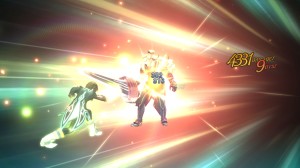 So far, we know Xillia has a great story, and is a riot to play… but how does it look? Well, one thing we need to remember before we get into that is that Xillia was originally released in Japan in 2011, two years before being released in North America. This means, although being released in 2013, the title is instantly going to look two years older. However, even with age working against it, Xillia still proves to be very easy on the eyes. While not as powerful as other JRPGs from recent years, Xillia has its own appealing cartoon-like aesthetic to it, thanks to a light degree of cell-shading and artistic intuition. Environments vary greatly, from dark black, blue, and purple cities built over water, to blue beaches crashing against giant, curved rocks, and villages of dome-shaped buildings on sweeping green plains. No environment looks like another in the game, which leaves players with a sense of a rich and diverse world, ready to explore!
So far, we know Xillia has a great story, and is a riot to play… but how does it look? Well, one thing we need to remember before we get into that is that Xillia was originally released in Japan in 2011, two years before being released in North America. This means, although being released in 2013, the title is instantly going to look two years older. However, even with age working against it, Xillia still proves to be very easy on the eyes. While not as powerful as other JRPGs from recent years, Xillia has its own appealing cartoon-like aesthetic to it, thanks to a light degree of cell-shading and artistic intuition. Environments vary greatly, from dark black, blue, and purple cities built over water, to blue beaches crashing against giant, curved rocks, and villages of dome-shaped buildings on sweeping green plains. No environment looks like another in the game, which leaves players with a sense of a rich and diverse world, ready to explore!
Part of what makes Xillia visually appealing includes the camera work, as it uses several different and unique angles. A good example of this is when you visit a town for the first time: the camera stays fixed behind your party as they walk and talk while crossing the entire area almost as though you were controlling them in play, creating a more personal atmosphere that you don’t typically see. While it may not sound like much in words, seeing it will make you a believer. Throw in the occasional anime cutscenes, brilliantly smooth and intense animations and action cinematics, as well as very believable facial expressions, and you have the beautiful Tales of Xillia. While it may not be a powerhouse of technological marvel, it is still a treat for your eyes.
The only slight issue in visuals comes down to accessories and how they sit on the characters’ bodies. Occasionally, an item just won’t be suited for a specific character, and its placement on him/her will ghost through an article of clothing or body part. A great example of this is Milla’s massive flowing hair. A lot of head and back pieces end up sticking out through her hair, which simply flows through it. While naturally a character’s hair will fall around or behind objects on their backs, these objects seem to go straight through the hair as if the item was solid and Milla herself was a ghost. As well, any character with coat-like clothing will have visual trouble with hip accessories (like swords), as the item will sit half inside of the clothing. While a very small issue, it actually is quite annoying both to your eye and to your personalization. You might really want to put that cute item on Elize, but visually her dress just won’t allow it, leading to disappointment and disillusionment.
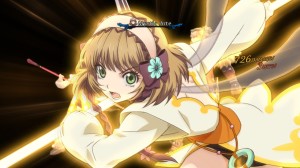 One more shining grace for Xillia is its audio, which is a blast to listen to. Returning players will instantly recognise the series’ musical feel, although all melodies and themes are new to Xillia. While set to a new tune, the strings and bright woodwinds for exploration and towns, as well as the rock-riffs used for combat have quite a familiar musical colour to them. These themes are used brilliantly to uplift your spirits, pull you into despair, or pump you up for a fight – there’s a song for every situation.
One more shining grace for Xillia is its audio, which is a blast to listen to. Returning players will instantly recognise the series’ musical feel, although all melodies and themes are new to Xillia. While set to a new tune, the strings and bright woodwinds for exploration and towns, as well as the rock-riffs used for combat have quite a familiar musical colour to them. These themes are used brilliantly to uplift your spirits, pull you into despair, or pump you up for a fight – there’s a song for every situation.
Accompanying the score is a great voice cast, who each bring their character to life perfectly. Whether it’s Jude’s caring attitude, Milla’s frank dedication, or Alvin’s mysterious charm, every line is delivered fantastically. Typically in a JRPG, it’s fairly common for lines and performances to be heavily overacted, either due to an idea being lost in translation, or the actor simply thinking that character should be really goofy and delivered their lines in a brash and ridiculous way. I’ve personally found it common to have a character in an anime game become someone I absolutely hate listening to in most English translations, a problem which Xillia actually lacks. Even the characters designed to be silly for comic relief end up coming off more as funny, and less annoying. For this game, it’s definitely in your best interest to pop on a high quality headset, sit back, and enjoy!
From the first opening cinematic to the final boss battle, every part of Tales of Xillia has been developed and conceived with care! From the in-depth narrative, unique combat, deep strategy options, lush visuals, and great soundtrack and cast, this game is a wonderful experience. A lack of an open world and a few visual anomalies hold it back from perfection, but this is by far one of the best JRPG releases to grace our consoles yet. If you’re a diehard Tales of fan, you probably already own this and can’t get enough; for new players though, this is the perfect place to jump into the series! Regardless, Xillia is sure to tickle any JRPG fan’s fancy, as well as win over some new players.
About This Post
